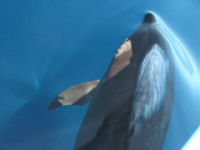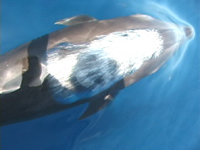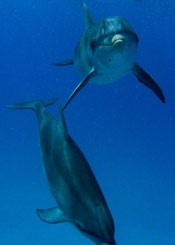This information is designed to help you learn more about our aquatic neighbors. We hope that the knowledge will lead you to an increased appreciation for these wonderful creatures.




Dolphins are not only fun to watch, they are an important part of a complex ecosystem and as an indicator species, the dolphins are a barometer of the health of our seas. Providing a safe place for them to live should be a main goal for us all.
Some basic facts: Dolphins are mammals. They are warm blooded, breathe air, give live birth to babies – they are not fish. There are approximately 57 species, most of which have an elongated beak called a rostrum.
Dolphins are Cetaceans and belong to a group of the toothed whales called Odontocetes. They live in both fresh/salt temperate and tropical waters worldwide.
The largest of all dolphins is the Orca, or Killer Whale, the oceans’ most powerful and fiercest creature.
Female dolphins become reproductively active at the age of 10-13 years and the males between 12-14 years. Female dolphins pregnancies last a year. They give birth to a single calf weighing 25-40 pounds and 24-36 inches long. They nurse for the first two years meanwhile the calf feeds exclusively on its’ mother’s milk. The babies remain with their mothers for the first 5-8 years, learning social and feeding skills from their family groups. Female dolphins usually rejoin their mother’s pod while male dolphins remain with other males, often forming lifelong cooperative coalitions. Juvenile dolphins of both sexes frequently leave the pods for extended periods of time.
Dolphins have a special sense called echo location which is used for navigation and to find food. Echo location involves making sounds in the sinus cavities. The sound is focused by an oil-filled sac on the dolphin’s forehead, and then projected toward objects in the water. When the sound strike any object it is then reflected back to the dolphin’s lower jaw, where it is passed to the dolphin’s brain. The animal can then form sound pictures based on the difference between the density of the object and the density of the water.
Dolphins have good eyesight but limited colour vision. Their eyes are designed for seeing in low light conditions, both in the air and in the water. They have an excellent sense of taste but no sense of smell.